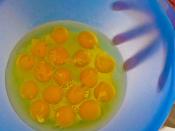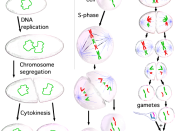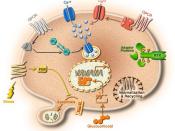Mitosis
Mitosis is the process of a cell dividing. A parent cell divides to create two identical daughter cells, which are exact replicas of the original parent cell. DNA is replicated, and each daughter cell receives one copy of the original DNA and the cell goes through a process consisting of 4 steps called mitosis.
Interphase, which isn't part of mitosis, is the "stage" when the cell is not in the process of dividing, but DNA is being replicated. Interphase itself has its three phases, G1 phase, S phase, G2 phase. During G1 phase, the cell grows in size in preparation for cell division. During S phase DNA is synthesized and copied for cell division. In G2 phase, DNA has already been synthesized and the cell continues to make proteins and grow for cell division.
Prophase, the first stage of mitosis, is when the proteins begin to condense in the cell and the replicated DNA prepares for division.
During early prophase, the nucleus disappears. Also the chromatin (DNA) coils into chromosomes, with each identical pair of chromosomes being attached in the center by a centromere. Centrioles move to the poles of the cell. During late prophase, the nuclear envelope disappears and the centrioles at the poles of the cell release spindles which will go to attach to the kinetochores, which are small specific regions of a centromere designed for attachment to the spindle apparatus.
In metaphase, the centrioles are aligned with each other at the top and bottom of the cell, and the pairs of chromosomes are aligned in the middle of the cell, known as the metaphase plate. The chromosomes move around until their kinetochores attach a spindle fiber to each chromosome.
During anaphase, the sister chromatids split and migrate to the poles of the cells. Each chromosome is...



Pretty good
It's a quite good and simple explanation of mitosis, but since we are talikng about mitosis you might want to explain meiosis as well.
Since you had a little intro before going to interphase, you could have a small conclusion as well.
Otherwise it was very good. Easy to understand.
1 out of 1 people found this comment useful.